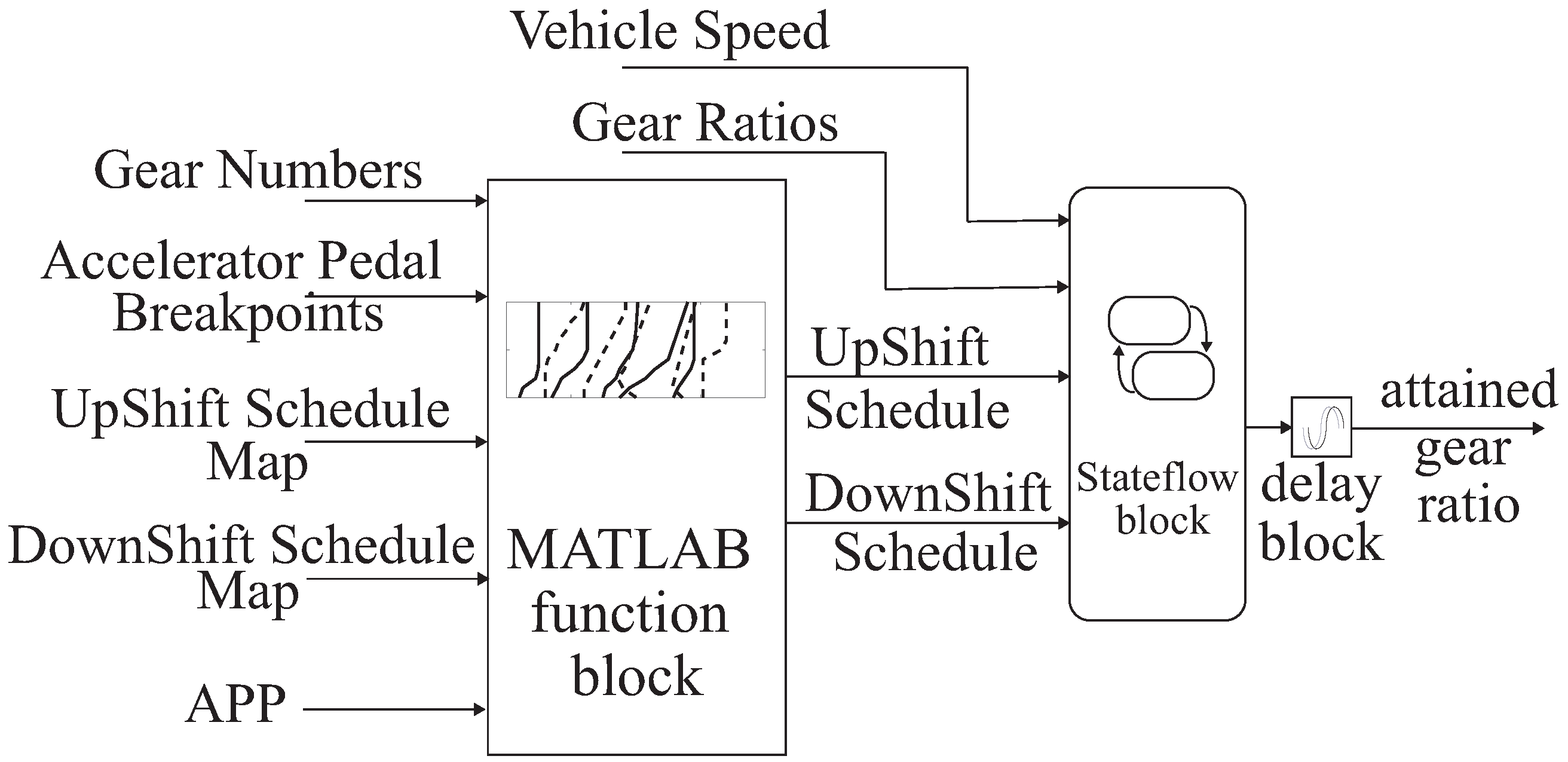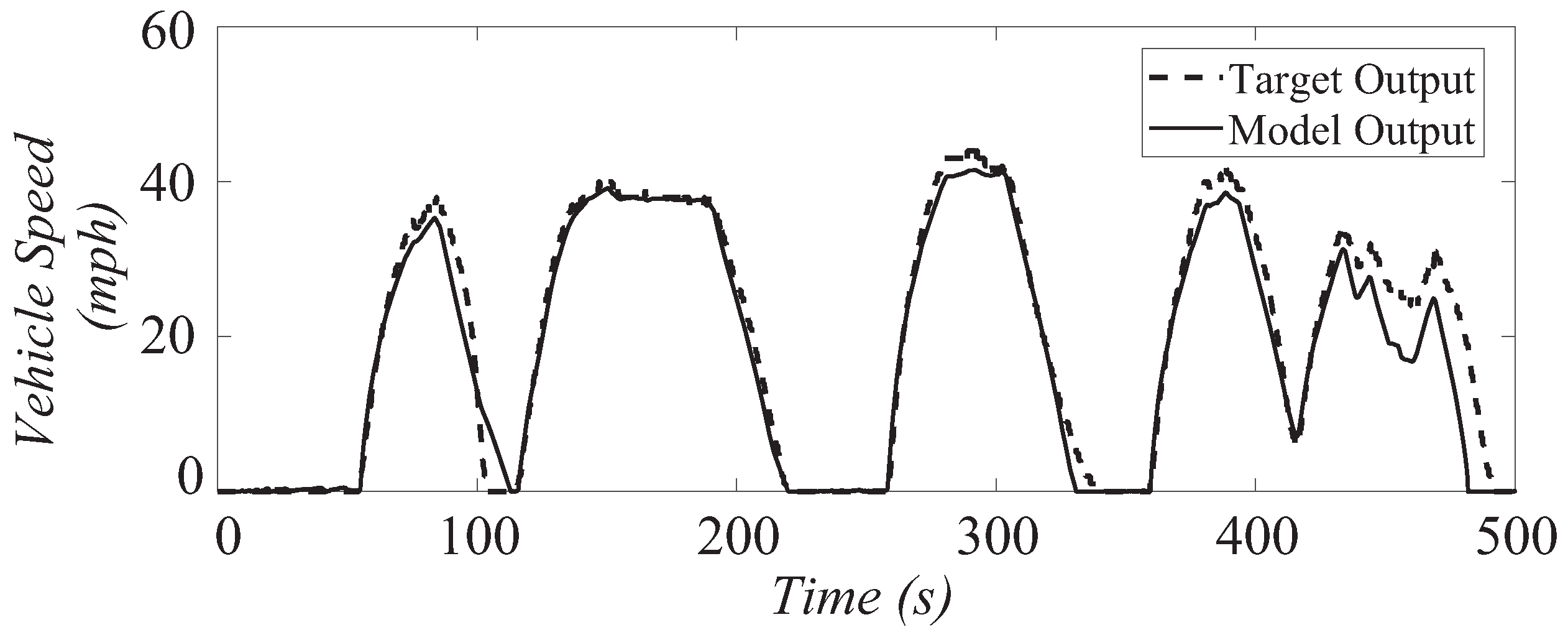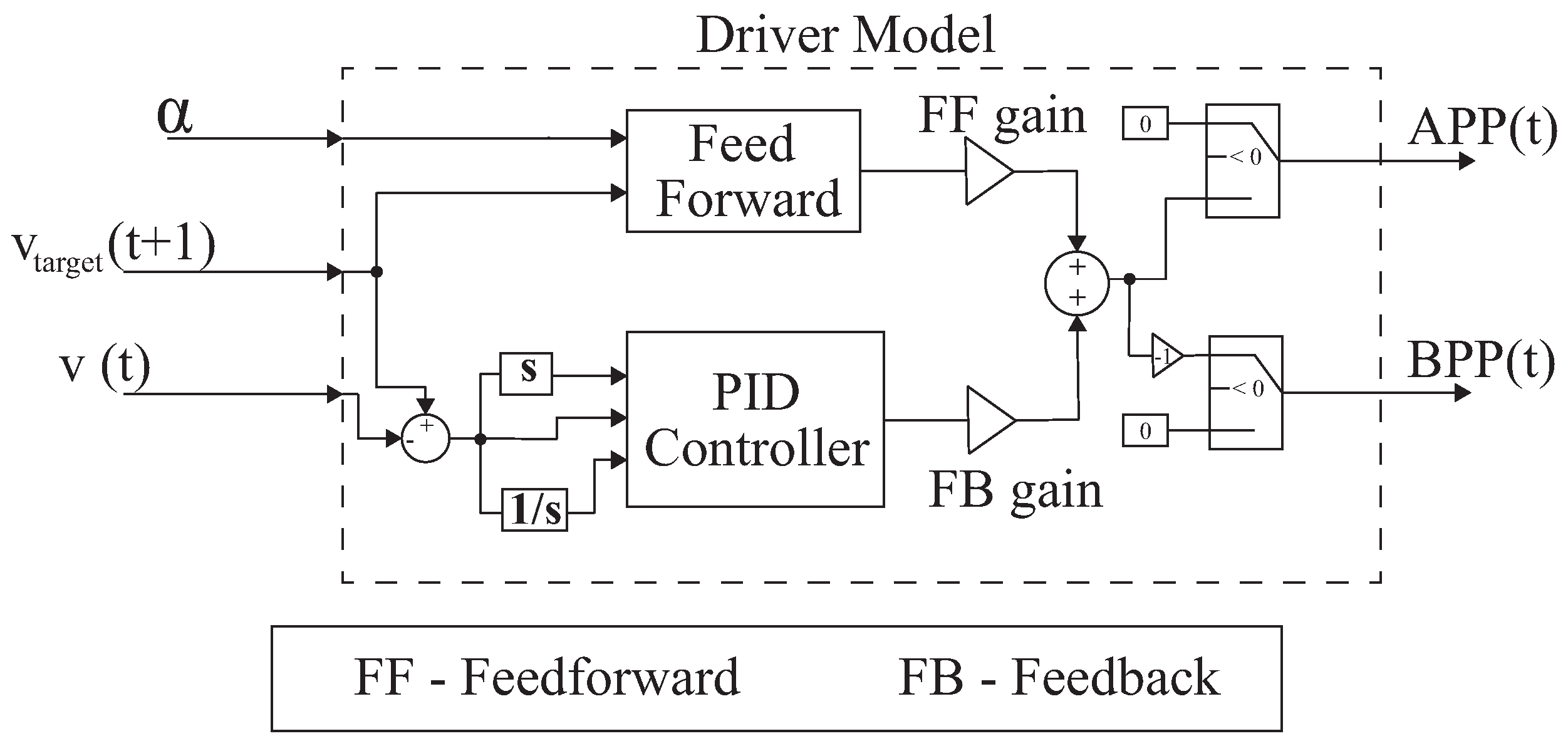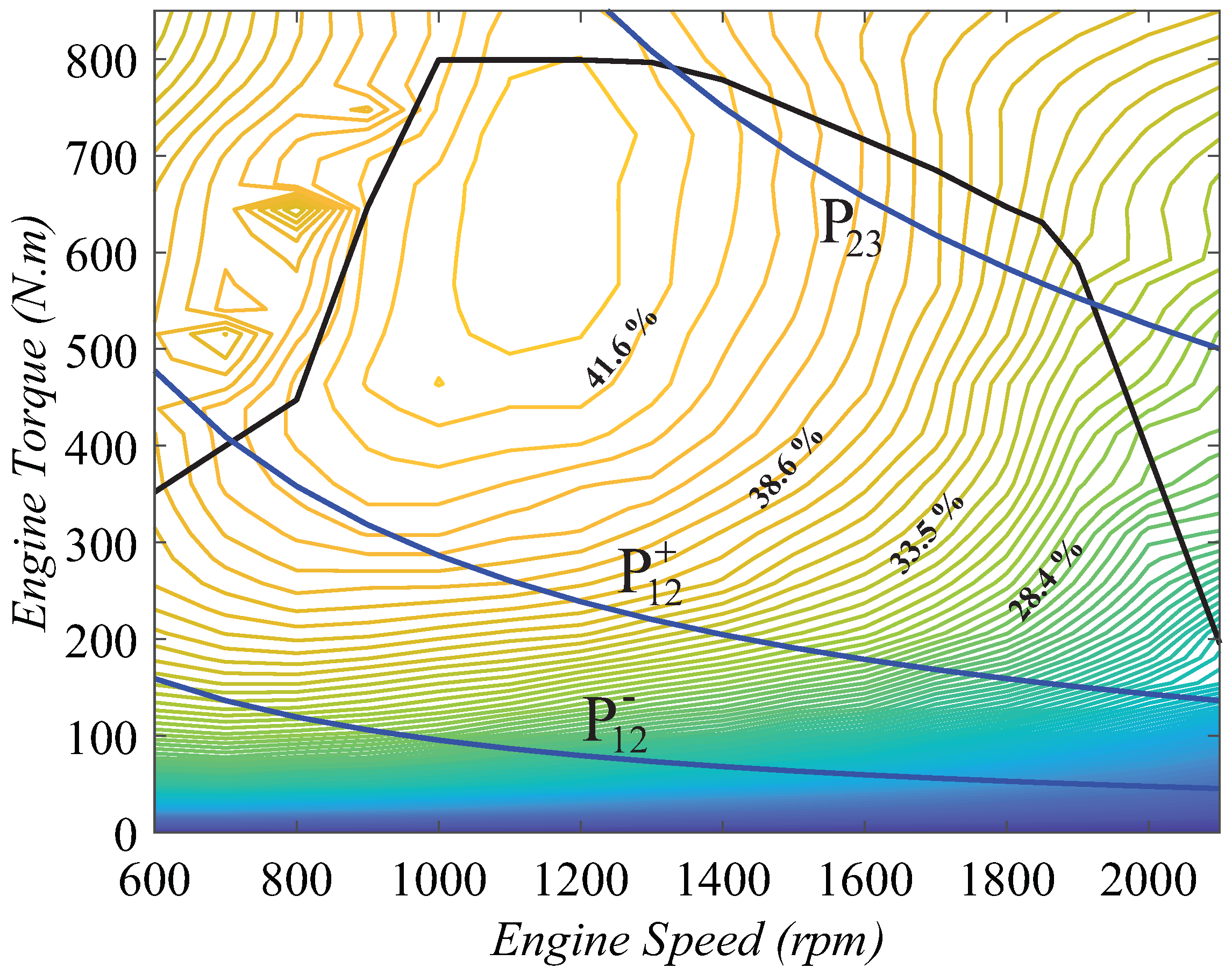Adaptive Rule-Based Energy Management Strategy for a Parallel HEV
Abstract
:1. Introduction
2. HEV Model
2.1. Notation
2.2. Engine Model
2.3. Transmission Model
2.4. Vehicle Roadload Model
2.5. Battery Model
2.6. Driver
3. Rule-Based Energy Management Strategy
3.1. Preliminary Rule-Based Strategy
- in region 1:
- -
- If , then all the requested power is provided by the battery.
- -
- Otherwise, the engine supplies + , where is delivered to the driveline and is used to recharge the battery.
- in region 2: In this case, is delivered by the engine irrespective of the value of .
- in region 3:
- -
- If , the engine supplies to the driveline and to charge the battery.
- -
- Otherwise, the engine delivers and the balance of the requested power (i.e., ) is provided by the battery.
- -
- If , then no power is absorbed by the battery and the vehicle must slow down using the friction brakes.
- -
- Otherwise, the battery is recharged through regenerative braking, i.e., the motor in the HEV acts as a generator, absorbs the net vehicle inertia and helps it to stop.
3.2. Adaptive Rule-Based Strategy
4. Performance Evaluation
5. Conclusions
Author Contributions
Funding
Conflicts of Interest
References
- Camara, M.B.; Gualous, H.; Gustin, F.; Berthon, A. Design and new control of DC/DC converters to share energy between supercapacitors and batteries in hybrid vehicles. IEEE Trans. Veh. Technol. 2008, 57, 2721–2735. [Google Scholar] [CrossRef]
- Thounthong, P.; Rael, S.; Davat, B. Energy management of fuel cell/battery/supercapacitor hybrid power source for vehicle applications. J. Power Sources 2009, 193, 376–385. [Google Scholar] [CrossRef]
- Polini, C.; Di Napoli, A.; Pede, G.; Rossi, E.; Villante, C. Energy management in hybrid electric vehicle with ICE and ultracapacitors. In Proceedings of the Electrical Systems for Aircraft, Railway and Ship Propulsion, Bologna, Italy, 19–21 October 2010; pp. 1–6. [Google Scholar]
- Severinsky, A.J. Hybrid Electric Vehicle. U.S. Patent No 5,343,970, 6 September 1994. [Google Scholar]
- December 2015 Hybrid Car Sales Numbers. Available online: https://www.hybridcars.com/december-2015-dashboard (accessed on 7 January 2019).
- Hybrids Account for Nearly 20 Percent of Cars in Japan. Available online: https://www.japantimes.co.jp/news/2018/10/27/business/hybrids-account-nearly-20-percent-cars-japan-automobile-association-says (accessed on 7 January 2019).
- Wang, X.; Li, L.; Yang, C. Hierarchical control of dry clutch for engine-start process in a parallel hybrid electric vehicle. IEEE Trans. Transp. Electrif. 2016, 2, 231–243. [Google Scholar] [CrossRef]
- Luo, Y.; Chen, T.; Zhang, S.; Li, K. Intelligent hybrid electric vehicle ACC with coordinated control of tracking ability, fuel economy, and ride comfort. IEEE Trans. Intell. Transp. Syst. 2015, 16, 2303–2308. [Google Scholar] [CrossRef]
- Zhang, P.; Yan, F.; Du, C. A comprehensive analysis of energy management strategies for hybrid electric vehicles based on bibliometrics. Renew. Sustain. Energy Rev. 2015, 48, 88–104. [Google Scholar] [CrossRef]
- Bianchi, D.; Rolando, L.; Serrao, L.; Onori, S.; Rizzoni, G.; Al-Khayat, N.; Hsieh, T.M.; Kang, P. A rule-based strategy for a series/parallel hybrid electric vehicle: an approach based on dynamic programming. In Proceedings of the ASME 2010 Dynamic Systems and Control Conference, Cambridge, MA, USA, 12–15 September 2010; American Society of Mechanical Engineers: New York, NY, USA, 2010; pp. 507–514. [Google Scholar]
- Wu, J.; Zhang, C.H.; Cui, N.X. PSO algorithm-based parameter optimization for HEV powertrain and its control strategy. Int. J. Automot. Technol. 2008, 9, 53–59. [Google Scholar] [CrossRef]
- Onori, S.; Serrao, L.; Rizzoni, G. Hybrid Electric Vehicles: Energy Management Strategies; Springer: Berlin/Heidelberg, Germany, 2016. [Google Scholar]
- Sun, C.; He, H.; Sun, F. The role of velocity forecasting in adaptive-ECMS for hybrid electric vehicles. Energy Procedia 2015, 75, 1907–1912. [Google Scholar] [CrossRef]
- Lin, C.C.; Peng, H.; Grizzle, J.W.; Kang, J.M. Power management strategy for a parallel hybrid electric truck. IEEE Trans. Control Syst. Technol. 2003, 11, 839–849. [Google Scholar]
- Banvait, H.; Anwar, S.; Chen, Y. A rule-based energy management strategy for plug-in hybrid electric vehicle (PHEV). In Proceedings of the American Control Conference, ACC’09, St. Louis, MO, USA, 10–12 June 2009; pp. 3938–3943. [Google Scholar]
- Schouten, N.J.; Salman, M.A.; Kheir, N.A. Fuzzy logic control for parallel hybrid vehicles. IEEE Trans. Control Syst. Technol. 2002, 10, 460–468. [Google Scholar] [CrossRef]
- Mansour, C.; Clodic, D. Dynamic modeling of the electro-mechanical configuration of the Toyota Hybrid System series/parallel power train. Int. J. Automot. Technol. 2012, 13, 143. [Google Scholar] [CrossRef]
- Huang, X.; Tan, Y.; He, X. An intelligent multifeature statistical approach for the discrimination of driving conditions of a hybrid electric vehicle. IEEE Trans. Intell. Transp. Syst. 2011, 12, 453–465. [Google Scholar] [CrossRef]
- Chen, Z.; Mi, C.C.; Xu, J.; Gong, X.; You, C. Energy management for a power-split plug-in hybrid electric vehicle based on dynamic programming and neural networks. IEEE Trans. Veh. Technol. 2014, 63, 1567–1580. [Google Scholar] [CrossRef]
- Karbowski, D.; Pagerit, S. Autonomie, a plug-and-play software architecture. In Proceedings of the Vehicle Power and Propulsion Conference, Lille, France, 1–3 September 2010. [Google Scholar]
- Brooker, A.; Gonder, J.; Wang, L.; Wood, E.; Lopp, S.; Ramroth, L. FASTSim: A Model to Estimate Vehicle Efficiency, Cost and Performance; Technical report; SAE Technical Paper No. 2015-01-0973; Society of Automotive Engineering (SAE) International: Warrendale, PA, USA, 2015. [Google Scholar]
- Lygoe, R. Fitting Automotive Microprocessor Control Look-Up Tables to a Response Surface Model Using Optimisation Methods; Technical report; SAE Technical Paper No. 981459; Society of Automotive Engineering (SAE) International: Warrendale, PA, USA, 1998. [Google Scholar]
- Markel, T.; Brooker, A.; Hendricks, T.; Johnson, V.; Kelly, K.; Kramer, B.; O’Keefe, M.; Sprik, S.; Wipke, K. ADVISOR: A systems analysis tool for advanced vehicle modeling. J. Power Sources 2002, 110, 255–266. [Google Scholar] [CrossRef]
- Bosch, R. Bosch Automotive Handbook, 5th ed.; Bentley Publishers: Cambridge, MA, USA, 2002. [Google Scholar]
- Moawad, A.; Rousseau, A. Impact of Transmission Technologies on Fuel Efficiency-Final Report; Report No. DOT HS; National Highway Traffic Safety Administration (NHTSA): Washington, DC, USA, 2012; Volume 811, p. 667.
- Gillespie, T.D. Fundamentals of Vehicle Dynamics; Technical report; SAE Technical Paper; Society of Automotive Engineering (SAE) International: Warrendale, PA, USA, 1992. [Google Scholar]
- Swift, A. Calculation of vehicle aerodynamic drag coefficients from velocity fitting of coastdown data. J. Wind. Eng. Ind. Aerodyn. 1991, 37, 167–185. [Google Scholar] [CrossRef]
- Pickenhain, S.; Burtchen, A. Optimal energy control of hybrid vehicles. In Modeling, Simulation and Optimization of Complex Processes HPSC 2015; Springer: New York City, NY, USA, 2017; pp. 179–188. [Google Scholar]
- Huria, T.; Ceraolo, M.; Gazzarri, J.; Jackey, R. High fidelity electrical model with thermal dependence for characterization and simulation of high power lithium battery cells. In Proceedings of the 2012 IEEE International Electric Vehicle Conference, Greenville, SC, USA, 4–8 March 2012; pp. 1–8. [Google Scholar]
- Harrop, P. 48V Mild Hybrid and 48V Full Hybrid Vehicles 2020–2030. 2019. Available online: https://www.idtechex.com/en/research-report/48v-mild-hybrid-and-48v-full-hybrid-vehicles-2020-2030/683 (accessed on 17 October 2019).
- Congress, G.C. Continental Presents 48V Full-Hybrid System; Motor Delivers up to 30 kW. 2019. Available online: https://www.greencarcongress.com/2019/07/20190702-conti.html (accessed on 17 October 2019).
- Kuypers, M. Application of 48 Volt for Mild Hybrid Vehicles and High Power Loads; Technical report; SAE Technical Paper No. 2014-01-1790; Society of Automotive Engineering (SAE) International: Warrendale, PA, USA, 2014. [Google Scholar]
- Jalil, N.; Kheir, N.A.; Salman, M. A rule-based energy management strategy for a series hybrid vehicle. In Proceedings of the 1997 American Control Conference (Cat. No. 97CH36041), Albuquerque, NM, USA, 6 June 1997; Volume 1, pp. 689–693. [Google Scholar]
- EPA. New Fuel Economy and Environment Labels for a New Generation of Vehicles; Regulatory Announcement EPA-420-F-11-017; US Environmental Protection Agency: Washington, DC, USA, 2011.
- US Department of Energy. Fuel Properties Comparison—Alternative Fuels Data Center. 2014. Available online: https://afdc.energy.gov/fuels/properties (accessed on 15 June 2019).
- Qadrdan, M.; Jenkins, N.; Wu, J. Smart Grid and Energy Storage. In McEvoy’s Handbook of Photovoltaics; Elsevier: Amsterdam, The Netherlands, 2018; pp. 915–928. [Google Scholar]
















| Engine | Diesel Engine with a maximum torque of 2100 N.m at 1200 rpm, a maximum efficiency of 43% and a maximum power of 321.44 kW. |
| Transmission | 6-speed automatic transmission with an 88% efficiency. |
| Battery | Lithium ion battery with a 48 V nominal voltage, a 2.82 kWh capacity and a 30-kW rated power. |
| Accessory load | 3 kW. |
| Parameters | Definition |
|---|---|
| Engine speed at time t. | |
| Engine torque at time t. | |
| Requested vehicle power at time t. | |
| Requested battery power at time t. | |
| Requested engine power at time t. | |
| Defines the boundary curve between regions 1 (motor) and 2 (engine) in the engine efficiency map. For the PRBS controller, this value is constant. For the ARBS controller, varies as a function of time. | |
| Defines the maximum/minimum power for the boundary between regions 1 (motor) and 2 (engine) for the ARBS controller. | |
| Defines the boundary curve between region 2 (engine) and region 3 (motor+engine) in the engine efficiency map. It is a constant for both the PRBS and the ARBS controllers. | |
| Constant margin for and in the PRBS controller. | |
| State of charge () of the battery at time t. | |
| Minimum/maximum allowable for the battery ( and ) | |
| Constant margin for and in the PRBS controller (). | |
| Reference value for the that the ARBS strategy tries to maintain (). | |
| Constant, predefined amount of power which is supplied by the engine to charge the battery. | |
| Gain of the proportional controller in the ARBS strategy (). |
| Parameters | Value |
|---|---|
| 0.625 | |
| 1.225 kg/m3 | |
| A | 10 m2 |
| 7000 kg | |
| g | 9.81 m/s2 |
| Duty Cycle | Driver | Distance (miles) | Behavior |
|---|---|---|---|
| 1 | 1 | 7.89 | good |
| 2 | 1 | 9.61 | bad |
| 3 | 2 | 9.69 | good |
| 4 | 2 | 9.78 | bad |
| 5 | 3 | 9.56 | good |
| 6 | 3 | 9.57 | bad |
| Power Parameters | Value (kW) |
|---|---|
| 0 to 27.5 | |
| 30 | |
| 0 to 27.5 | |
| 110 | |
| 1.5 | |
| 5 | |
| 30 | |
| -30 |
© 2019 by the authors. Licensee MDPI, Basel, Switzerland. This article is an open access article distributed under the terms and conditions of the Creative Commons Attribution (CC BY) license (http://creativecommons.org/licenses/by/4.0/).
Share and Cite
Bagwe, R.M.; Byerly, A.; dos Santos, E.C., Jr.; Ben-Miled, Z. Adaptive Rule-Based Energy Management Strategy for a Parallel HEV. Energies 2019, 12, 4472. https://doi.org/10.3390/en12234472
Bagwe RM, Byerly A, dos Santos EC Jr., Ben-Miled Z. Adaptive Rule-Based Energy Management Strategy for a Parallel HEV. Energies. 2019; 12(23):4472. https://doi.org/10.3390/en12234472
Chicago/Turabian StyleBagwe, Rishikesh Mahesh, Andy Byerly, Euzeli Cipriano dos Santos, Jr., and Zina Ben-Miled. 2019. "Adaptive Rule-Based Energy Management Strategy for a Parallel HEV" Energies 12, no. 23: 4472. https://doi.org/10.3390/en12234472





